In the preceding lesson titled “Causes to Post-Covid Syndrome”, I listed and explained the four Causes to Post-Covid Syndrome; those being:
- Continuance of immune system dysregulation leading to persistent inflammatory conditions.
- Exacerbation of pre-Covid19 inflammatory conditions associated with existing chronic diseases.
- Exacerbation of pre-Covid19 silent inflammatory conditions.
- Unresolved organ damage that happened during Covid19 acute phase.
However, these direct causes don’t stand alone. They are, in fact, consequential outcomes of deeper, foundational disturbances within the body. In essence, these four causes are the byproducts of even more fundamental root causes. To draw a clearer picture: the Underlying Root Causes give rise to the four causes we discussed, which in turn, culminate in Post-Covid Syndrome.
So in this lesson, we delve deep into the Underlying Root Causes of Post-Covid Syndrome, unraveling the complex web of factors that contribute to its existence and persistence. As with all matters of health, understanding is the first step towards healing. By the end of this lesson, you will gain a comprehensive insight into the intricate factors contributing to this condition and appreciate the importance of a holistic approach to treatment and recovery. Armed with this knowledge, Post-Covid Syndrome patients can make more informed decisions towards their treatment and their path towards recovery and optimal health.
What are the underlying root causes to Post-Covid Syndrome? #
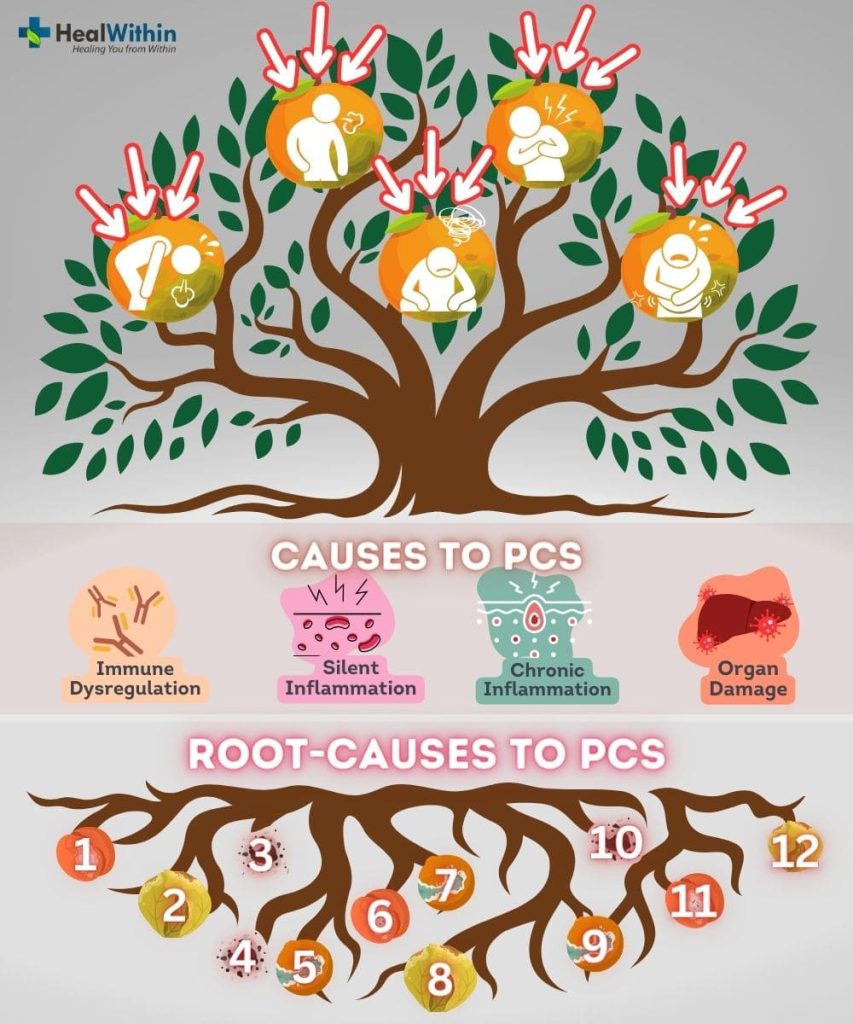
From our extensive research & clinical experience in “Heal Within,” and through the lens of an integrated and holistic medical perspective, we have identified an array of Underlying Root Causes to Post-Covid Syndrome, after observing and treating numerous Post-Covid Syndrome patients. Those identified root causes are:
- High blood sugar
- Toxins & heavy-metals
- Essential nutrient deficiency
- Poor oxygenation
- Mitochondrial dysfunction
- Chronic mental stress
- Sub-optimal blood & lymph circulation
- Dissonant EMF (electromagnetic field) disturbances
- Hormonal imbalances
- Gut Dysbiosis (imbalance of gut microbiota)
- Inadequate sleep and circadian rhythm disruption
- Viral persistence
NOTE: It’s essential to understand that not every Post-Covid Syndrome patient will exhibit all these root causes. In fact, the specific underlying causes can vary significantly from one individual to another. Pinpointing the precise root causes for each patient is paramount in designing and implementing the most effective treatment regimen. Recognizing and addressing these individualized factors is the cornerstone of a holistic approach, ensuring a path towards full recovery.
OF EACH ROOT CAUSE
1. High Blood Sugar / Diabetes #
How High Blood Sugar / Diabetes can be an underlying root cause to Post-Covid Syndrome?
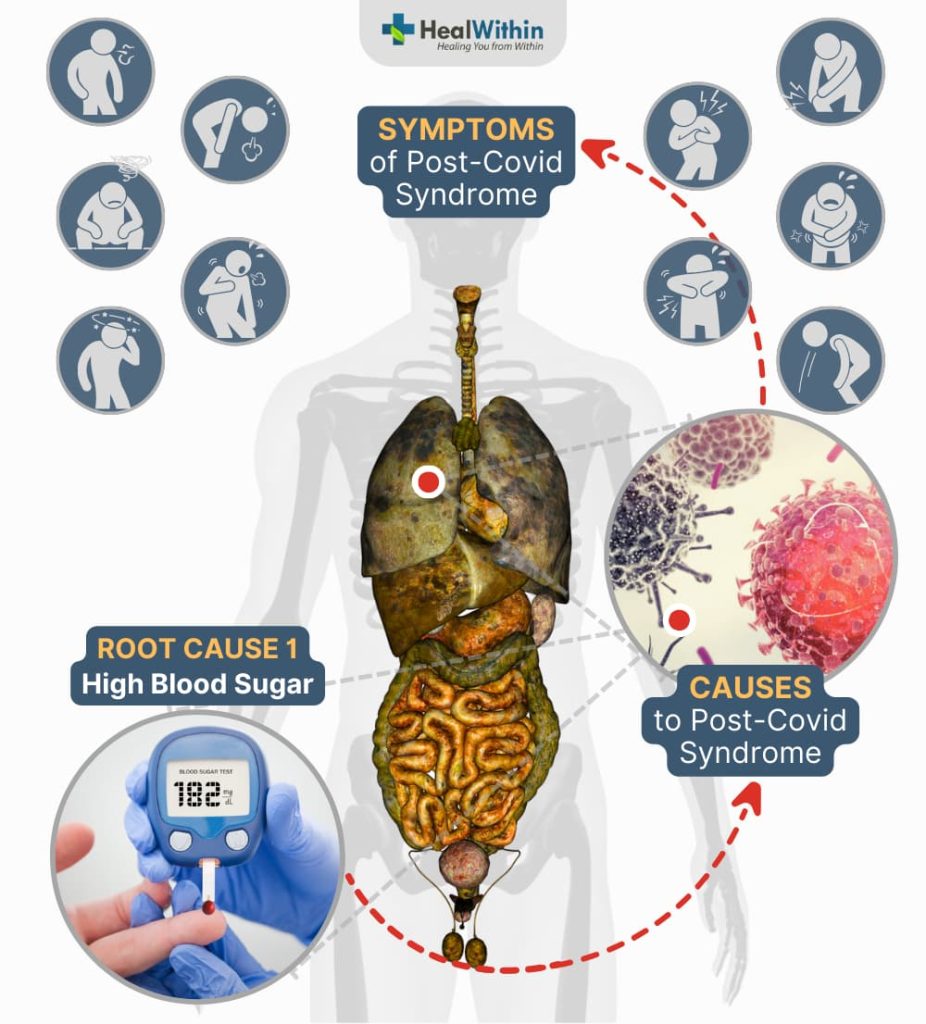
High blood sugar, also known as hyperglycemia, occurs when there is an excess of glucose in the bloodstream. This can be a result of the body’s inability to produce enough insulin, inefficient use of insulin, or consumption of excessive amounts of sugar and carbohydrates.
High blood sugar can lead to chronic inflammation, as evidenced by elevated levels of inflammatory markers such as C-reactive protein (CRP), interleukin-6 (IL-6), tumor necrosis factor-alpha (TNF-alpha), and Erythrocyte sedimentation rate (ESR). The inflammatory conditions associated with high blood sugar, marked by these elevated inflammatory markers, are seen to exacerbate during the acute phase of COVID-19 (i.e., during the initial viral infection phase). These exacerbated levels of the inflammatory conditions persist even after the viral infection is resolved, thus contributing to Post-Covid Syndrome (which is the exacerbation and persistence of inflammatory conditions associated with chronic diseases that existed prior to Covid-19 – as explained in the earlier lesson “Causes to Post-Covid Syndrome”. Additionally, elevated blood sugar levels can impair immune system function, making it more difficult for the body to fight off infections and recover from the virus. Studies have shown that individuals with pre-existing conditions like diabetes are at a higher risk of developing severe Covid-19 and may be more susceptible to Post-Covid Syndrome.
2. Toxins & Heavy-metals #
How Toxins & Heavy-metals can be an underlying root cause to Post-Covid Syndrome?
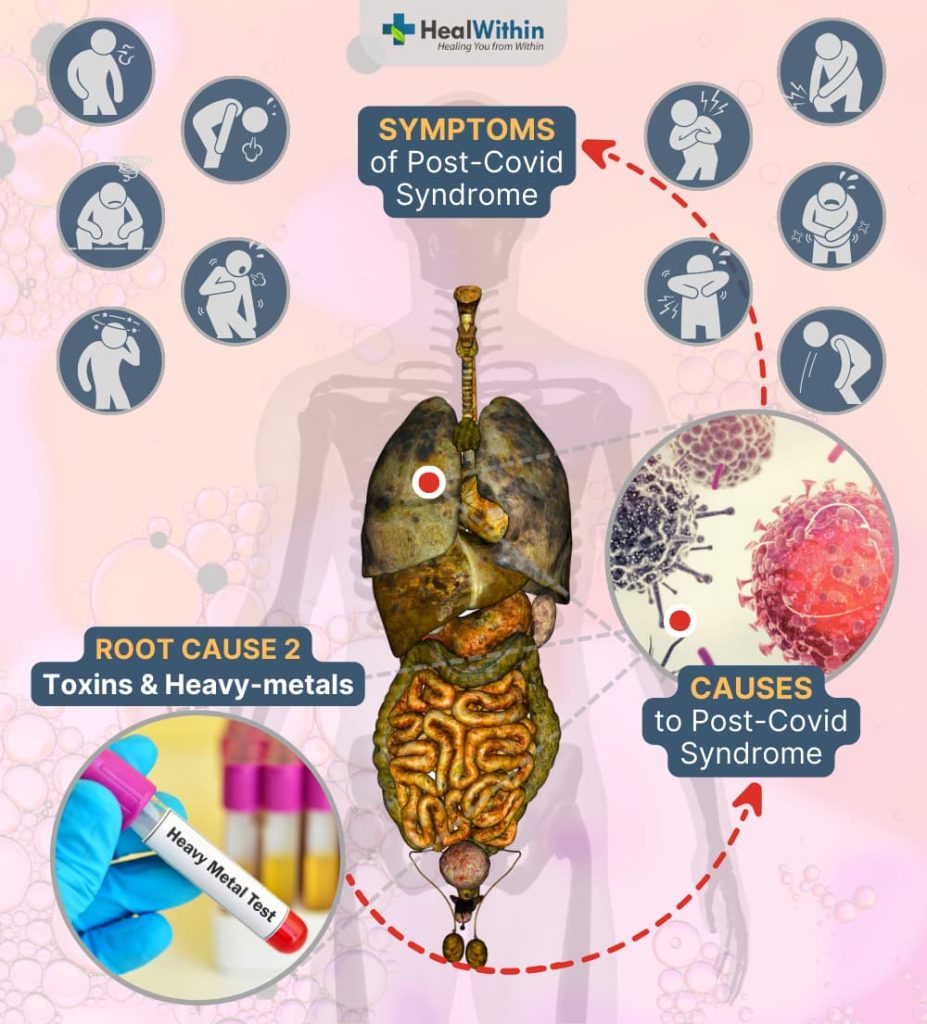
Toxins and heavy-metals are substances that can cause harmful effects in the body when ingested or absorbed beyond a certain homeostatic threshold. (In this context, the homeostatic threshold represents the maximum level of these substances that the body can naturally detoxify without any harmful effects, and varies for each individual.) Toxins can come from various sources, including environmental pollutants and chemicals in food and water. Heavy-metals, such as lead, mercury, cadmium, and arsenic, are a certain group of metals that when ingested into the body tend to accumulate in organs & connective tissues and trigger harmful effects.
Toxins and heavy-metals can negatively impact overall health and well-being, as they can interfere with normal functions of the body’s organs and systems when present beyond the homeostatic threshold. The immune system, in particular, can be adversely affected by the presence of toxins and heavy-metals, resulting in a weakened ability to fight off infections, including the SARS-CoV-2 virus and recover from the illness. Moreover, accumulated toxins and heavy-metals can contribute to chronic inflammation, dysbiosis, acidosis, and other harmful effects, which are seen to exacerbate upon the initial Covid-19 infection, and also seen to persist at those exacerbated levels even after the initial Covid-19 infection is treated and resolved, thus contributing to Post-Covid Syndrome. In addition, the body’s natural detoxification mechanism may also be hindered in the presence of Post-Covid Syndrome, further exacerbating the issue.
3. Essential Nutrients Deficiency #
How Essential nutrient deficiency can be an underlying root cause to Post-Covid Syndrome?
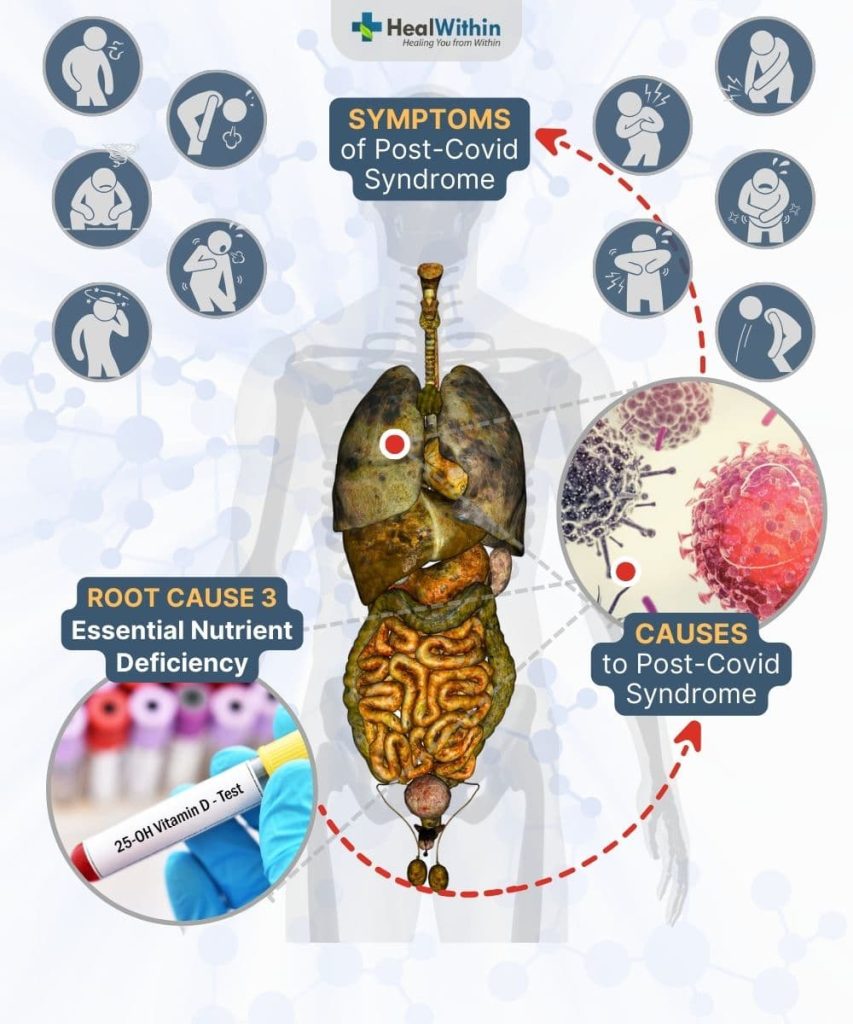
Essential nutrient deficiency occurs when the body lacks one or more essential nutrients required for its proper functioning. These nutrients include vitamins, minerals, amino acids, and essential fatty acids, which cannot be synthesized by the body and must be obtained through diet or supplementation.
A deficiency in essential nutrients can negatively impact overall health and well-being, as it can impair the normal functioning of the body’s organs and systems. Specifically, nutrient deficiencies can weaken the immune system, reducing its ability to fight off infections, including the SARS-CoV-2 virus, and recover from the illness. Moreover, deficiencies in certain nutrients, such as vitamin D, zinc, and magnesium, have been linked to increased inflammation and oxidative stress, which are seen to exacerbate upon the onset of COVID-19 and continue to persist at those exacerbated levels even after Covid-19 is treated and resolved, thus contributing to Post-Covid Syndrome.
4. Poor Oxygenation #
How Poor oxygenation can be an underlying root cause to Post-Covid Syndrome?
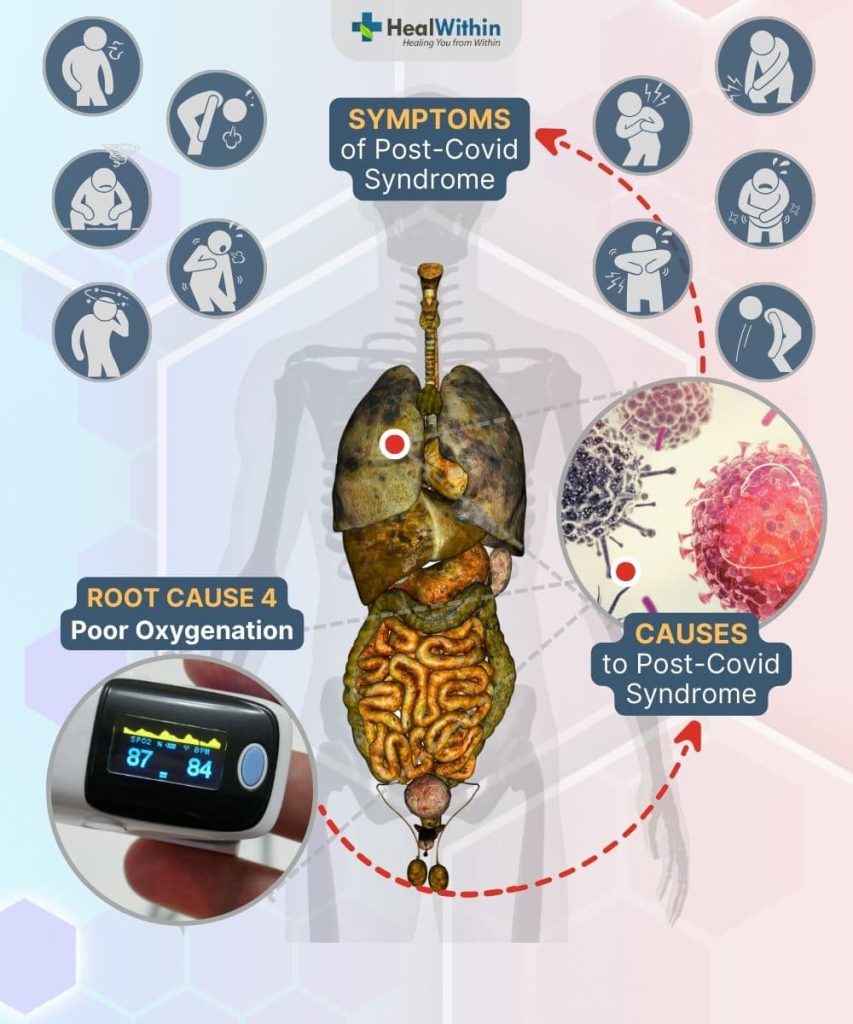
Poor oxygenation refers to the inadequate delivery of oxygen to the body’s cells and tissues; good oxygenation is necessary for maintaining optimal cellular function and overall health. Poor oxygenation can be affected by various factors, such as poor circulation, lung disorders, anemia, and certain lifestyle habits like smoking or sedentary behavior.
Poor oxygenation can negatively impact overall health and well-being, as it can impair the normal functioning of the body’s organs and systems. Specifically, inadequate oxygenation can weaken the immune system, reducing its ability to fight off infections, including the SARS-CoV-2 virus, and recover from illness. Additionally, poor oxygenation can lead to increased inflammation, oxidative stress, and tissue damage, are seen to exacerbate during the acute phase of COVID-19 (i.e., during the initial viral infection phase), and persist at that exacerbated levels even after COVID-19 is treated and resolved, thus contributing to Post-Covid Syndrome.
Symptoms of poor oxygenation may include shortness of breath, fatigue, rapid heart rate, dizziness, and pale or cyanotic (blue-tinged) skin. In the context of Post-Covid Syndrome, poor oxygenation may contribute to ongoing fatigue, shortness of breath, and exercise intolerance, as well as exacerbate other symptoms related to the condition.
5. Mitochondrial Dysfunction #
How Mitochondrial dysfunction can be an underlying root cause to Post-Covid Syndrome?
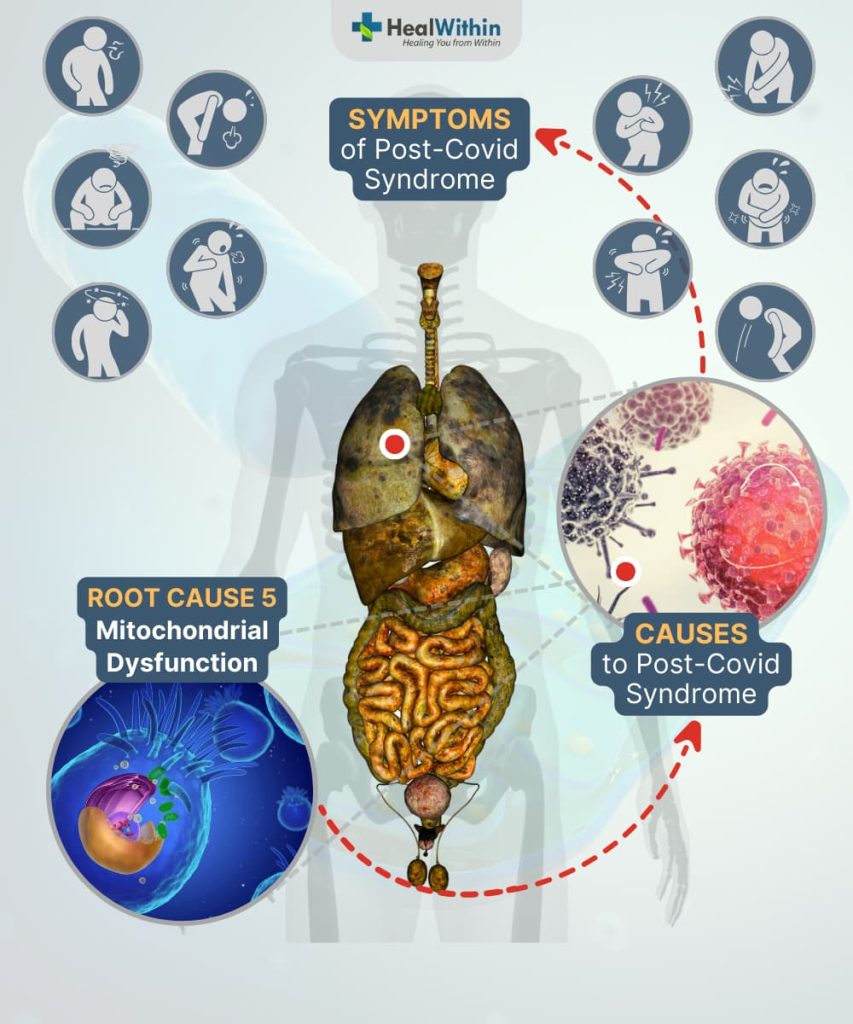
Mitochondrial dysfunction refers to the impaired functioning of the mitochondria, which are the energy-producing structures within the body’s cells. The mitochondria play a critical role in generating the energy needed to support cellular function and overall health. Dysfunction can be caused by various factors, such as genetic mutations, oxidative stress, inflammation, and exposure to environmental toxins.
Mitochondrial dysfunction can contribute to the development or persistence of Post-Covid Syndrome by negatively impacting cellular energy production, which is essential for proper immune system function and tissue repair. A weakened immune system may have difficulty fighting off the SARS-CoV-2 virus and may struggle to clear the remnants of the virus effectively. As a result, lingering viral particles or immune system overactivation can lead to chronic inflammation and oxidative stress.
Additionally, poor mitochondrial function can hinder tissue repair and regeneration, prolonging the healing process after the acute phase of COVID-19. This can result in the persistence of symptoms such as fatigue, cognitive difficulties, and exercise intolerance, even COVID-19 is treated, thus contributing to Post-Covid Syndrome. Moreover, this persistence of chronic inflammation and oxidative stress can further exacerbate mitochondrial dysfunction, creating a vicious cycle that further contributes to the ongoing nature of Post-Covid Syndrome.
6. Chronic Mental Stress #
How Chronic mental stress can be an underlying root cause to Post-Covid Syndrome?
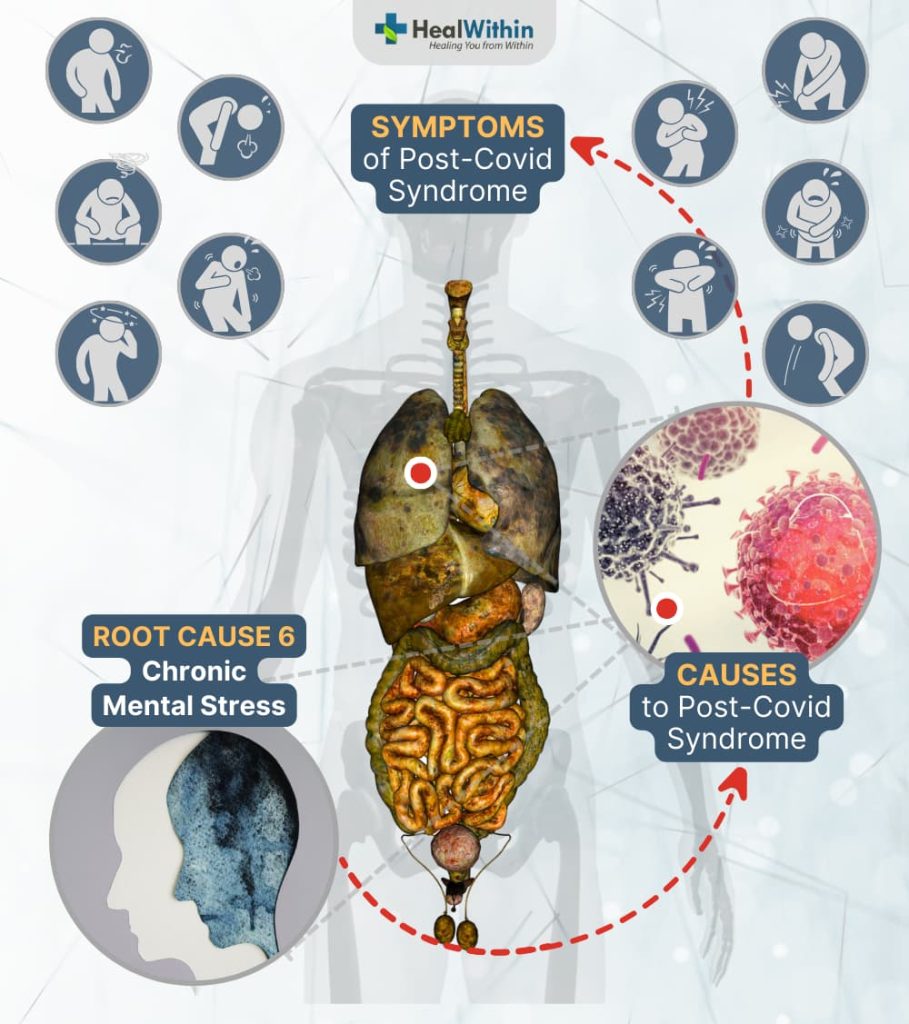
Chronic mental stress refers to the ongoing experience of psychological stress that can result from various sources, such as work, relationships, financial problems, or health concerns. It can lead to a persistent state of activation in the body’s stress response system, including the hypothalamic-pituitary-adrenal (HPA) axis and the sympathetic nervous system.
Chronic mental stress can contribute to the development of Post-Covid Syndrome in several ways. Prolonged activation of the body’s stress response system can lead to dysregulation of the immune system, making it less effective in fighting off infections like the SARS-CoV-2 virus and recovering from illnesses. This immune dysregulation can exacerbate during the initial COVID-19 infection phase, and thereby exacerbate the existing chronic inflammation and tissue damage, which persist at exacerbated levels even after COVID-19 infection is treated, thus contributing to Post-Covid Syndrome.
Additionally, chronic mental stress can impair the body’s ability to maintain homeostasis, leading to hormonal imbalances and disruption of essential bodily functions. This disruption can also contribute to the persistence of Post-Covid Syndrome symptoms such as fatigue, cognitive difficulties, and sleep disturbances. Furthermore, the psychological burden of chronic stress can worsen the emotional and mental well-being of individuals with Post-Covid Syndrome, adding to the overall severity of the condition.
Lastly, chronic mental stress may also hinder the effectiveness of the body’s natural healing processes, prolonging the recovery time from the acute phase of COVID-19 and contributing to the development of Post-Covid Syndrome.
7. Sub-optimal Blood & Lymph Circulation #
How Sub-optimal blood & lymph circulation can be an underlying root cause to Post-Covid Syndrome?

Sub-optimal blood and lymph circulation refers to the inefficient or impaired flow of blood and lymphatic fluid throughout the body. Blood circulation is vital for delivering oxygen and nutrients to cells and tissues, while lymphatic circulation is essential for removing waste products and maintaining proper immune function. Factors that can contribute to sub-optimal circulation include sedentary lifestyles, obesity, smoking, and certain medical conditions like diabetes, heart disease, and venous insufficiency.
Sub-optimal blood and lymph circulation can contribute to the development or persistence of Post-Covid Syndrome by impacting the body’s ability to effectively deliver essential nutrients and oxygen to cells, remove waste products, and maintain optimal immune function. Inefficient blood circulation may limit the body’s capacity to repair damaged tissues and maintain the proper functioning of organs, which can contribute to the persistence of COVID-19 symptoms such as fatigue, shortness of breath, and exercise intolerance, even after the viral infection is treated, thus contributing to Post-Covid Syndrome.
Moreover, impaired lymphatic circulation can lead to a buildup of waste products and toxins in the body, resulting in increased inflammation and oxidative stress. This accumulation can further weaken the immune system, making it more difficult to clear remnants of the SARS-CoV-2 virus and recover from the acute phase of COVID-19. In turn, these factors can contribute to the development and persistence of Post-Covid Syndrome.
8. Dissonant EMF (electromagnetic field) Disturbances #
How Dissonant EMF (electromagnetic field) disturbances can be an underlying root cause to Post-Covid Syndrome?
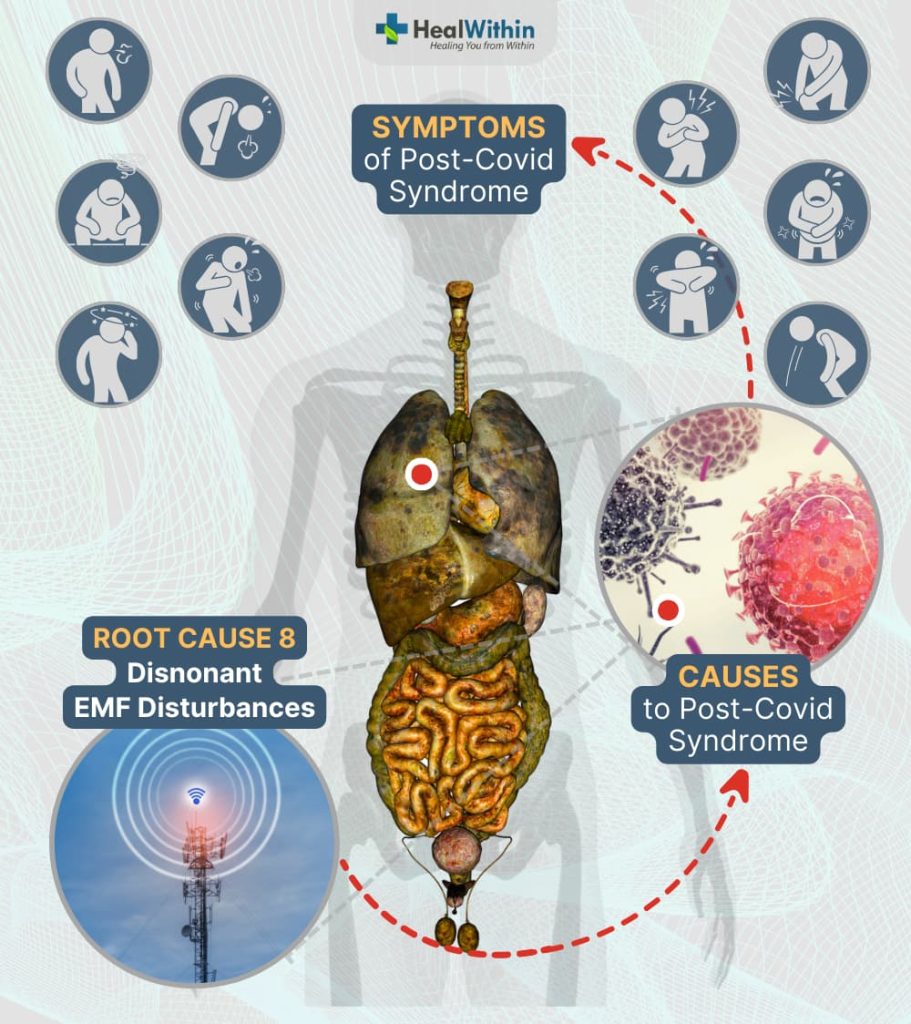
Dissonant electromagnetic fields (EMFs) are invisible areas of energy, often referred to as radiation, that are produced by electrically charged objects and which are non-harmonious with the natural bioelectrical processes of the human body. Dissonant EMF disturbances refer to the destructive-interference of EMF fields with that in the human body. Common sources of dissonant EMF disturbances include cell phones, Wi-Fi routers, microwave ovens, power lines, and electronic devices like computers and televisions.
Prolonged or excessive exposure to artificial, dissonant EMFs may interfere with the normal functioning of cells and disrupt the body’s innate bioelectrical processes, leading to increased oxidative stress, inflammation, and cellular damage, which is seen to exacerbate during the acute phase of COVID-19 (i.e., during the initial viral infection phase), and persist at exacerbated levels even after COVID-19 is treated, thus contributing to Post-Covid Syndrome.
In addition, dissonant EMF disturbances may weaken the immune system, reducing its ability to effectively combat infections like the SARS-CoV-2 virus and recover from illness. This weakened immune response may contribute to the development and persistence of Post-Covid Syndrome by allowing remnants of the virus to linger in the body or by causing an overactive immune response that leads to chronic inflammation and tissue damage. Furthermore, dissonant EMF disturbances may disrupt the body’s hormonal balance and impair the functioning of the nervous system, contributing to symptoms such as fatigue, sleep disturbances, and cognitive difficulties commonly associated with Post-Covid Syndrome.
9. Hormonal Imbalances #
How Hormonal imbalances can be an underlying root cause to Post-Covid Syndrome?

Hormones are chemical messengers that regulate various physiological processes, such as growth, metabolism, stress response, and immune function. Hormonal imbalances are basically a chronic change in the normal levels of all hormones in the body. This occurs when there is an irregularity in the production or function of hormones within the body. A variety of factors can contribute to hormonal imbalances, including chronic stress, poor diet, environmental toxins, and certain medical conditions.
Hormonal imbalances can contribute to the development or persistence of Post-Covid Syndrome by affecting the body’s ability to recover from the initial infection, maintain a healthy immune response, and cope with the ongoing stress of the condition. Imbalances in hormones, such as cortisol (the stress hormone), thyroid hormones, or sex hormones, can weaken the immune system, increase inflammation, and disrupt normal cellular processes, which exacerbate during the acute phase of COVID-19, and persist even after COVID-19 is treated causing the persistence of symptoms such as fatigue, cognitive difficulties, and sleep disturbances, thus contributing to Post-Covid Syndrome. Hormonal imbalances may also contribute to a prolonged recovery period, as the body’s natural healing processes are disrupted by the imbalances.
10. Gut Dysbiosis (imbalance of gut microbiota) #
How Gut dysbiosis (imbalance of gut microbiota) can be an underlying root cause to Post-Covid Syndrome?
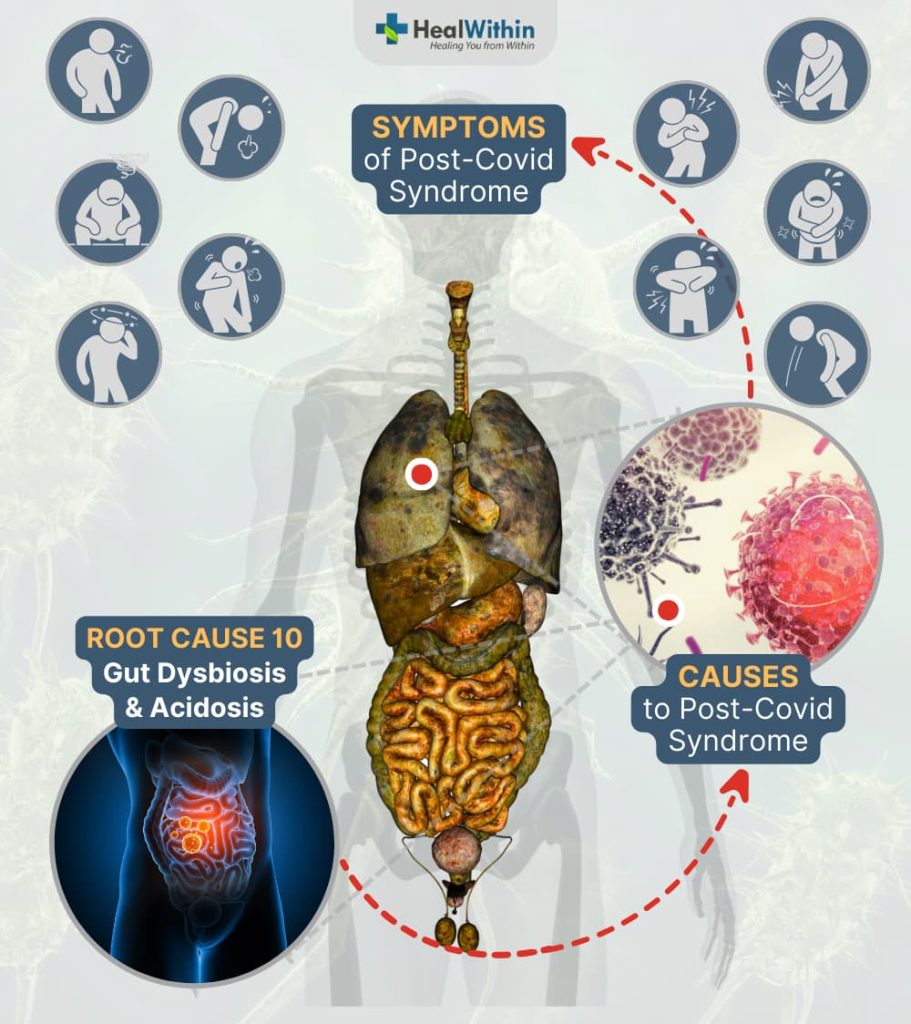
Gut dysbiosis refers to an imbalance in the composition of the gut microbiota, which is the community of microorganisms living in the gastrointestinal tract. These microorganisms play a crucial role in digestion, immune function, and the production of essential nutrients and neurotransmitters. Factors that can contribute to gut dysbiosis include poor diet, chronic stress, antibiotic use, and exposure to environmental toxins.
Gut dysbiosis can contribute to the development or persistence of Post-Covid Syndrome by impairing the body’s immune response, increasing inflammation, and disrupting the production of essential nutrients and neurotransmitters. An imbalanced gut microbiota can lead to a weakened immune system, making it more difficult for the body to recover from the initial SARS-CoV-2 infection. Consequently, the body could suffer from mild to severe organ damage during the acute phase of COVID-19 or not be able to fully rid-off all virus debris even after the acute phase. This causes inflammation to persist long after COVID-19 and thus contributes to Post-Covid Syndrome.
Furthermore, gut dysbiosis can result in increased production of inflammatory compounds and decreased production of essential nutrients and neurotransmitters, which are necessary for maintaining overall health and well-being. In the context of Post-Covid Syndrome, these imbalances may exacerbate during COVID-19 acute phase, and persist long after the acute phase causing persistent symptoms such as fatigue, cognitive difficulties, and mood disturbances, thus further contributing to Post-Covid Syndrome.
11. Inadequate Sleep and Circadian Rhythm Disruption #
How Inadequate sleep and circadian rhythm disruption can be an underlying root cause to Post-Covid Syndrome?
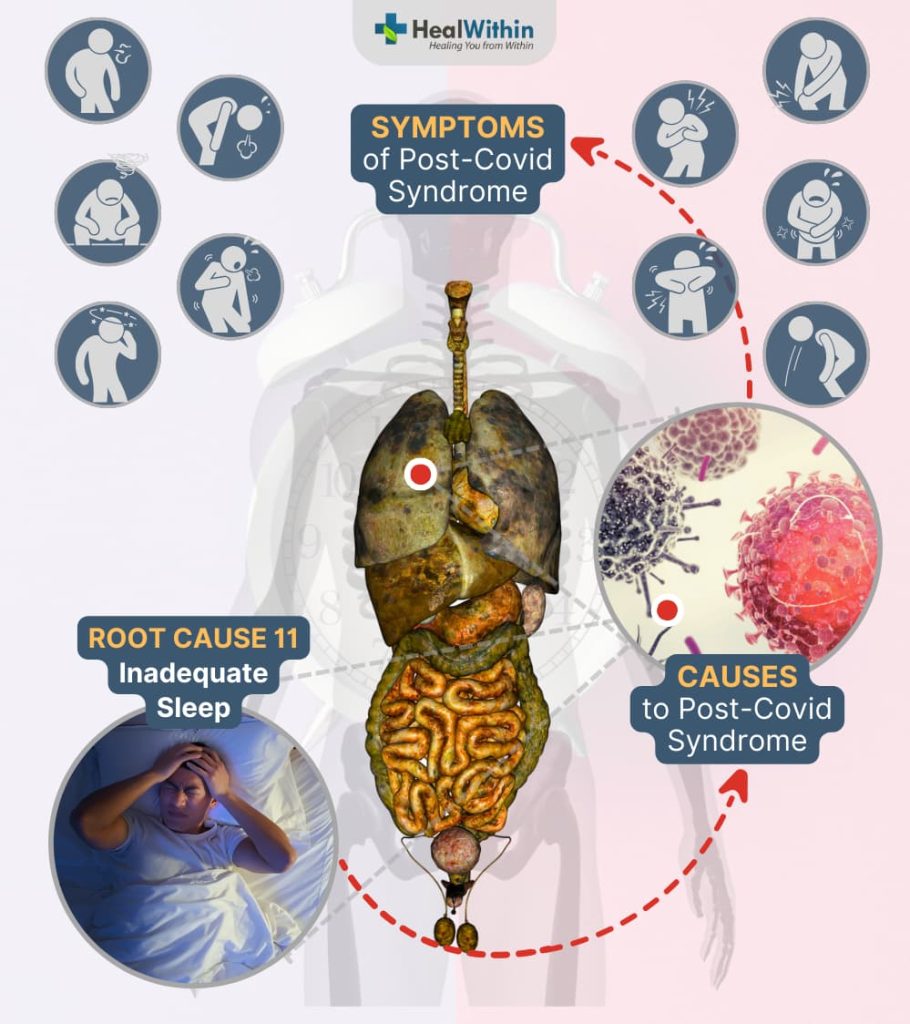
Inadequate sleep refers to insufficient or poor-quality sleep, which can result from various factors, including stress, poor sleep hygiene, or underlying sleep disorders. Circadian rhythm disruption occurs when the body’s internal clock, which regulates sleep-wake cycles and various other physiological processes, becomes misaligned with external factors such as light-dark cycles and social schedules. This disruption can lead to sleep disturbances, hormonal imbalances, and impaired overall health.
Inadequate sleep and circadian rhythm disruption can impair the immune system, making it less effective in fighting off infections, including the SARS-CoV-2 virus, and in recovering from illness. Sleep is essential for proper immune function, and a lack of sleep can result in increased inflammation and oxidative stress, which can exacerbate during the acute phase of COVID-19 (i.e., during the initial viral infection phase) and persist at that exacerbated levels even after COVID-19 is treated and resolved, thus contributing to Post-Covid Syndrome.
Additionally, disrupted sleep and circadian rhythms can lead to hormonal imbalances, which can further contribute to the development or persistence of Post-Covid Syndrome. For example, cortisol, the primary stress hormone, follows a circadian pattern, and disruptions in this pattern can result in chronic stress and inflammation, perpetuating the symptoms of Post-Covid Syndrome.
12. Viral Persistence #
How Viral persistence can be an underlying root cause to Post-Covid Syndrome?
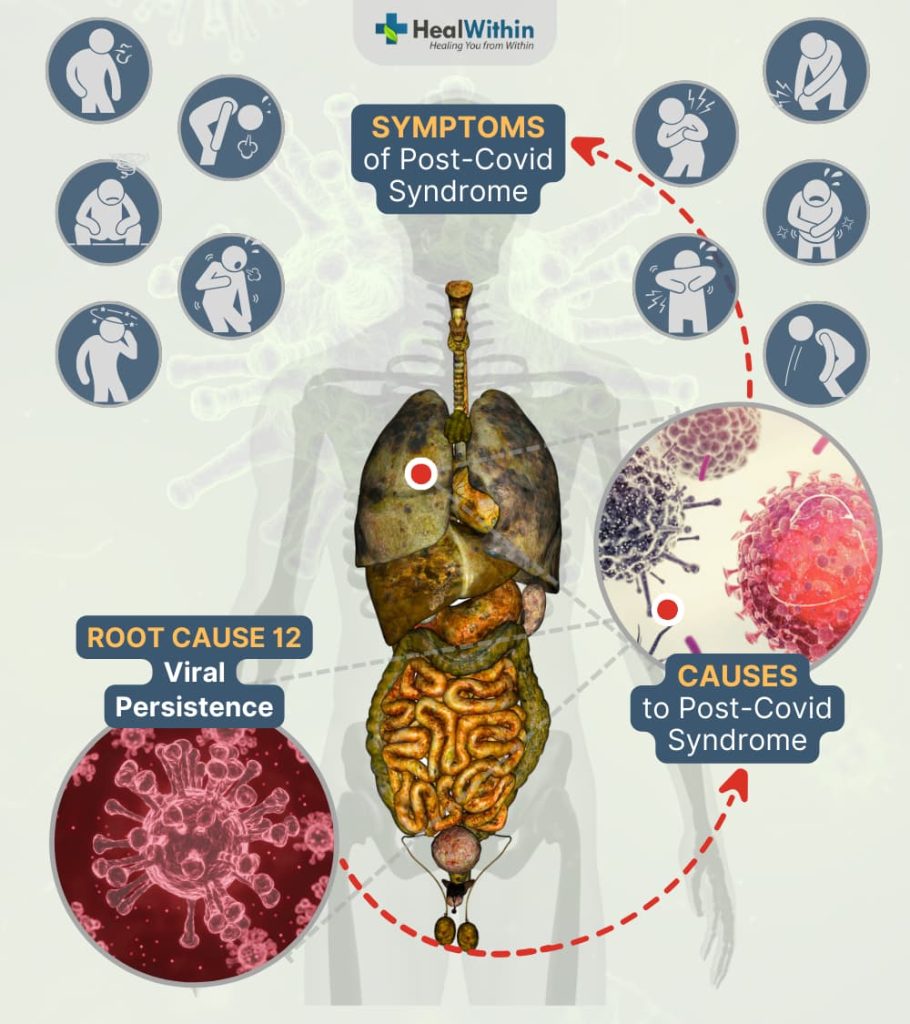
Viral persistence refers to the continued presence of a virus, or viral particles, within the body even after the acute phase of an infection has resolved. In some cases, the virus may remain dormant in certain cells or tissues, with the potential to reactivate and cause symptoms or disease at a later time. Viral persistence can be influenced by factors such as the immune system’s ability to eliminate the virus, viral mutations, or the presence of other co-infections.
Viral persistence of the SARS-CoV-2 virus or viral remnants in the body may contribute to the development or persistence of Post-Covid Syndrome by causing ongoing inflammation and immune system activation, even after the acute phase of COVID-19 has resolved. The presence of viral particles can trigger a chronic hyperactive immune system, leading to persistent inflammation and immune-mediated tissue damage, which causes symptoms of COVID-19 to persist even long after the acute phase, thus contributing to Post-Covid Syndrome.
Additionally, if the virus or viral remnants remain in certain tissues or organs, they may directly contribute to organ dysfunction, further exacerbating the symptoms of Post-Covid Syndrome. For example, if viral persistence occurs in the nervous system, it could lead to neurological symptoms, such as brain fog or memory difficulties.
Why is it important to identify and address these root causes for effective treatment and recovery from Post-Covid Syndrome? #
Addressing the underlying root causes to Post-Covid Syndrome is essential to effectively treat and totally recover from this condition. By understanding the unique factors contributing to an individual’s symptoms, it is possible to create targeted, personalized treatment plans that yield sustainable results. The following points highlight the importance of identifying and addressing these root causes:
- Targeted treatments: Recognizing the specific root causes affecting each patient allows healthcare providers to design more accurate and personalized interventions, which in turn can lead to improved treatment outcomes and symptom relief.
- Preventing symptom recurrence: Properly addressing the root causes reduces the chances of symptoms reappearing after an initial period of improvement. This helps to ensure a more stable and lasting recovery.
- Long-term recovery: Gaining a deeper understanding of the root causes of Post-Covid Syndrome paves the way for more sustainable health improvements. Comprehensive treatment plans that address these underlying factors can promote long-term recovery and overall health.
- Reduced complications: Tackling the root causes can help patients avoid potential health complications associated with Post-Covid Syndrome. This proactive approach minimizes the risk of additional health problems and supports a more efficient recovery.
- Optimal well-being: Addressing the root causes not only helps to effectively treat Post-Covid Syndrome but also effectively treats any other chronic diseases, and thus induce holistic healing and promotes overall health and well-being. By addressing these underlying issues, patients can experience improved physical, mental, and emotional health, leading to a better quality of life long-term.
Summary and Conclusion #
In summary, Post-Covid Syndrome is a multifaceted condition that requires a diagnosis of both its Causes and its Root-Causes. Identifying the Causes provides the first level of insight and identifying the root-causes provides a comprehensive view, which is necessary to tailor and administer a personalised and most-effective treatment, to totally resolve Post-Covid Syndrome and effectively treat any other co-existing chronic diseases, induce holistic healing (whole body healing), prevent recurrences, and promote good quality of life long-term.
If you or a loved one are experiencing persistent symptoms after recovering from COVID-19, and now understand the necessity of diagnosing the causes and underlying root causes, I invite you to come to my centre Heal Within® – an Integrated & Holistic Chronic Disease Treatment Centre.
At Heal Within®, me and my team of expert integrated and holistic medical professionals are committed to ensuring that the causes and the root causes of every patient’s symptoms are identified and the most-effective treatment is personalised and administered . We are dedicated to providing personalized care and attention to each patient, helping you navigate the complexities of Post-Covid Syndrome with confidence. Don’t let lingering symptoms hold you back from living your best life — schedule a consultation at Heal Within today and take the first step towards healing and recovery.
























